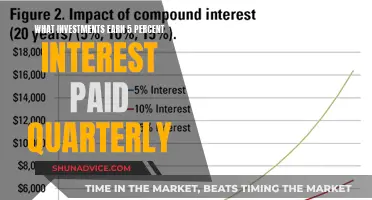
Negative interest rates are a challenging environment for investors, as it's an unprecedented situation. In this context, investors have to pay to lend money, and the traditional relationship between risk and reward is disrupted. Bonds, which are usually a stable investment, may not be a reliable source of yield. Investors will have to accept more volatility to achieve higher returns, or accept lower returns for more stability. This article will explore how investors can navigate this tricky landscape.
| Characteristics | Values |
|---|---|
| Investor mindset | Think about the dividends from the stock portion of your portfolio as a source of income |
| Bonds | Think about bonds in terms of protection, not yield |
| Stock market | The stock market becomes more important when rates are on the floor |
| Volatility | To earn higher returns, you have to accept more volatility |
| Stability | To have more stability, you have to accept lower returns |
What You'll Learn

How to think about bonds
In a negative interest rate world, you have to change the way you think about bonds. Most investors think about bonds in terms of yield or income, but in a negative interest rate environment, bonds should be thought of in terms of protection, not yield. The stock market becomes more important when rates are on the floor, but that doesn't mean you can forsake bonds or cash altogether. Bonds can still provide a source of income, and this income is much more stable than the price movements in the stock market.
In a negative interest rate environment, investors get to pay someone else for the privilege of lending them money. However, if the bond's price falls low enough, a negative-coupon-rate bond could still produce a positive yield. In this case, the market price can remain the same as the face value or par value, and a simple negative coupon rate will make the yield negative. In real life, most bonds with negative yields are zero-coupon bonds issued by countries like Germany and Switzerland.
When thinking about bonds, it's important to remember that the vast majority of returns in bonds over time come from the starting yield, not price appreciation. This means that investors should focus on the starting yield when considering bonds. Additionally, in a negative interest rate environment, there are no easy solutions. To earn higher returns, you will have to accept more volatility. To have more stability, you will have to accept lower returns. The risk-reward relationship has always been in place, but the returns paid for stability are drastically lower than they've been in the past.
It's also worth noting that in a negative interest rate environment, the market prices of bonds can get bid up, making the yields negative. This is something to be aware of when considering investing in bonds.
Mastering the Art of Time and Compound Interest
You may want to see also

The importance of the stock market
Investing during negative interest rates is not an easy task. No one knows the implications of a negative yield world because it has never happened to this extent before. However, the stock market becomes more important when rates are low.
Investors should not forsake bonds or cash altogether, but they should think about the dividends from the stock portion of their portfolio as a source of income. These are much more stable than the price movements in the stock market.
Bonds should be thought of in terms of protection, not yield. In a negative interest rate world, investors have to change the way they think about bonds.
To earn higher returns, investors will have to accept more volatility. To have more stability, they will have to accept lower returns. This risk-reward relationship has always been in place, but the returns paid for stability are drastically lower than they have been in the past.
Maximizing Investments: Understanding Annual Interest Returns
You may want to see also

How to earn higher returns
In a negative interest rate world, investors need to change the way they think about bonds. Bonds are usually thought of in terms of yield or income, but in this environment, they should be thought of in terms of protection. The stock market becomes more important when rates are low, but bonds and cash should not be forsaken altogether. Dividends from the stock portion of your portfolio can be a stable source of income.
To earn higher returns, you will need to accept more volatility. To have more stability, you will need to accept lower returns. This risk-reward relationship has always been in place, but the returns paid for stability are now drastically lower than they have been in the past.
In a negative interest rate environment, investors get to pay someone else for the privilege of lending them money. However, if the bond's price falls low enough, a negative-coupon-rate bond could still produce a positive yield. In this case, the market price can remain the same as the face value or par value, and a simple negative coupon rate will make the yield negative. In real life, most bonds with negative yields are zero-coupon bonds issued by countries like Germany and Switzerland.
Investors should invest in the markets as they are, not as they wish them to be. This may require a re-framing of how investors think about risk in their portfolio.
Maximizing Investment Returns: Calculating Daily Accrued Interest
You may want to see also

The risk-reward relationship
In a negative interest rate environment, investors need to change the way they think about bonds. Instead of thinking about bonds in terms of yield or income, investors should think about them in terms of protection. The stock market becomes more important when rates are low, but this doesn't mean investors should forsake bonds or cash altogether. Dividends from the stock portion of a portfolio can be thought of as a source of income, and they are much more stable than the price movements in the stock market.
In this environment, the risk-reward relationship remains in place, but the returns paid for stability are drastically lower than they have been in the past. To earn higher returns, investors must accept more volatility, and to have more stability, they must accept lower returns.
In a negative interest rate world, there are no easy solutions. No one knows the implications of a negative yield world because it has never happened to this extent before. Investors will have to invest in the markets as they are, not as they wish them to be. This may require a re-framing of how investors think about risk in their portfolios.
Impact of High Interest Rates on Investment Demand
You may want to see also

How to invest in a negative-yielding debt
Negative interest rates are a challenging environment for investors. No one knows the implications of a negative yield world because it has never happened before to this extent. There are no easy solutions. To earn higher returns, you’re going to have to accept more volatility in some form or another. To have more stability, you’re going to have to accept lower returns.
In a negative interest rate world, you have to change the way you think about bonds. Think about bonds in terms of protection, not yield. The stock market becomes more important when rates are on the floor but that doesn’t mean you can forsake bonds or cash altogether.
Most investors think about bonds in terms of yield or income. And why shouldn’t they? The vast majority of returns in bonds over time come from the starting yield, not price appreciation. But if you’re able to think about the dividends from the stock portion of your portfolio as a source of income, they are much more stable than the price movements in the stock market.
As an investor, you get to pay someone else for the privilege of lending them money. But hey, if the bond’s price falls low enough, a negative-coupon-rate bond could still produce a positive yield: In this case, the market price can remain the same as face value or par value and a simple negative coupon rate will make the yield negative. This is how bond investing “should” work: you earn modest interest income during the holding period and then earn back your principal upon maturity.
Understanding Interest-Free Investments: Classifying Returns
You may want to see also
Frequently asked questions
Negative interest rates mean that investors pay to lend money.
You have to accept that the market is different from what you're used to. You'll need to change the way you think about bonds and be prepared to accept more volatility to earn higher returns.
The risk-reward relationship has always been in place, but the returns paid for stability are drastically lower than they've been in the past.
Dividends from the stock portion of your portfolio can be a stable source of income.







